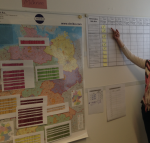For creative tension, improve flow
Some ideas are sticky, and none more so that ideas about ideas.
The rough consensus since the 1920s is that creative insights occur during the free-flowing, loose-association thought process when one tries to solve a challenging problem. Creativity is sparked by the tension between an (imagined) ideal state and a (perceived) current condition. In other words, new ideas stem from the problems we try to solve, first as a variety of imagined solutions, then as concrete possibilities as we experiment or run mental scenarios or through sheer self-belief, out of which we then fixate on a preferred solution we try to make work in real life.
The question is: What problems should we solve?
The Lean answer is: Improve flow.
In business, improving flow has two huge advantages :
- It always improves the business as faster is always better than slower: faster response to customers, shorter lead-times, faster circulation of cash and capital, faster adoption of new tech;
- It reveals technical problems and competency gaps: as you improve flow, some problems are simple to solve, and others far more challenging – often revealing that a technical process is either 1) very poor in quality or 2) very cumbersome, requiring a “monument,” which involves batching, queues, and low efficiencies – as we hit the technical limits of what we know, and must find new, creative, solutions.
There is a lot of emphasis in improving the downstream flow, as for instance, with Takt Time to better deliver to customers (and reduce finished good inventories) or with Pull Systems to improve efficiencies (and reduce WIP), but improving upstream flow can also have a huge impact on the business.
For instance, by systematically creating milk-run pick-up routes to suppliers, this German Logistics manager has improved overall inventory turns by a third in less than two years

With a spectacular impact on the business as a whole, from better on-time-delivery to much improved cash position.
To spur creativity, you need to both prepare the grounds by solving daily performance problems, but also set greater challenges to get minds thinking. More often than not, without a crystal ball, the future is mysterious and we’re advancing in the “fog of war”, so what challenges should we set? When in doubt, improve flow. This will give you instant benefits as well as revealing the strengths and weaknesses of your operations, and the specific technical challenges you need to face.









